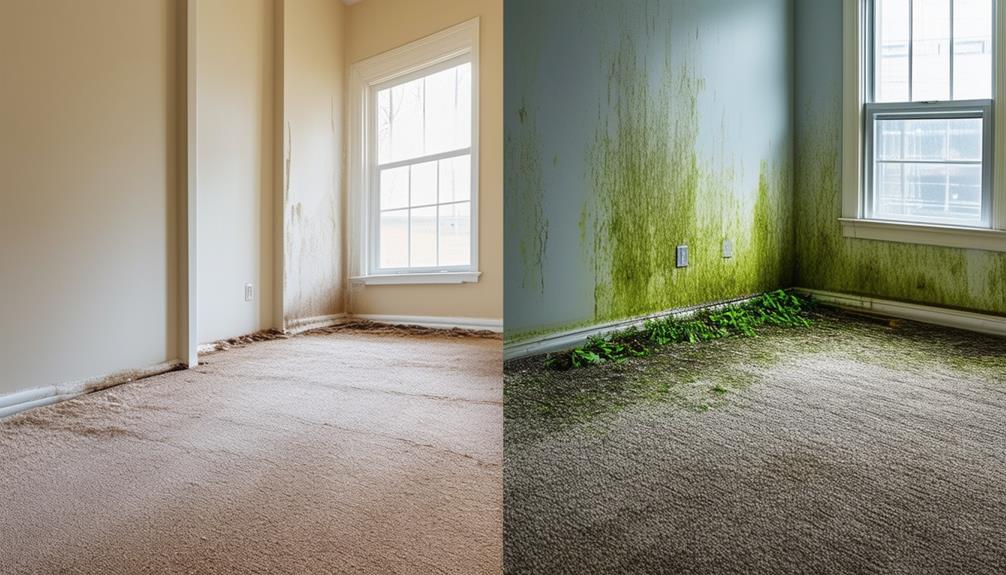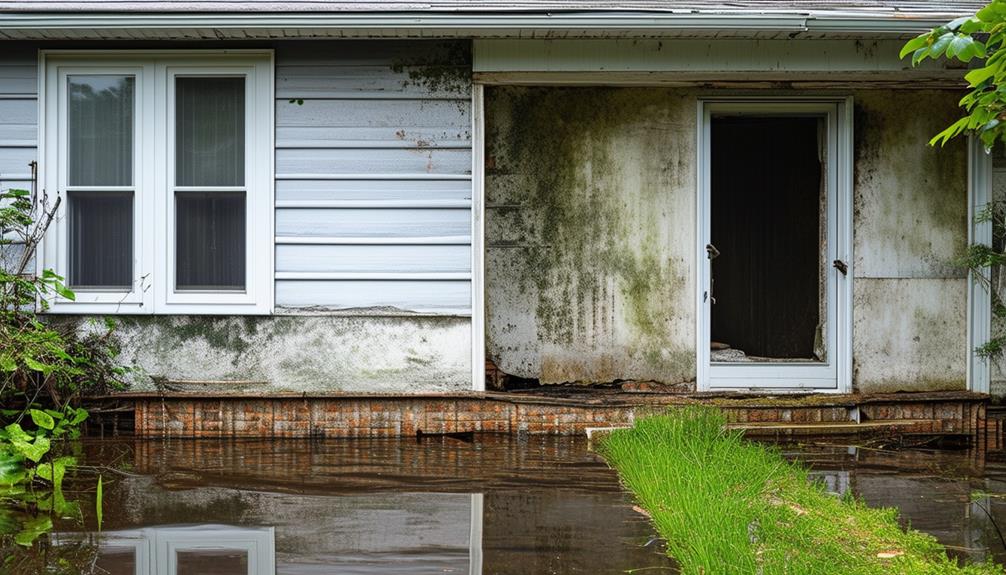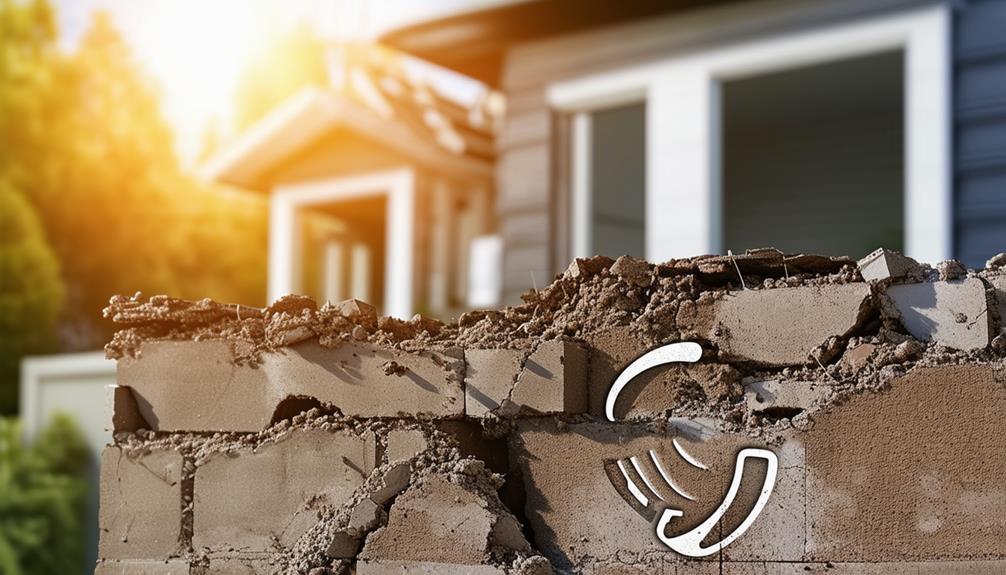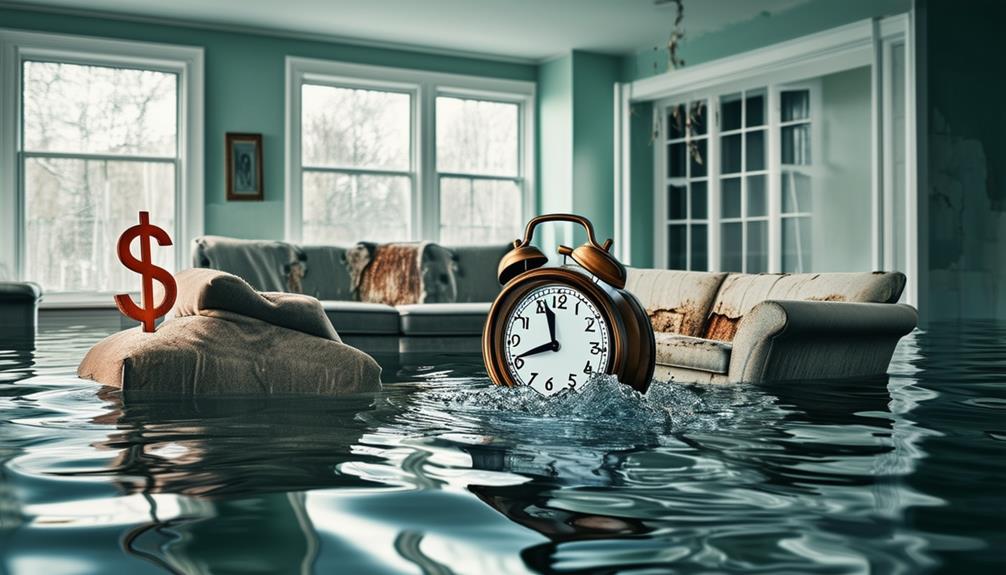Water damage repair should be your first call after a flood as immediate action is crucial in preserving your property’s structural integrity. Professionals efficiently identify and rectify all sorts of water damage, saving you future costs and headaches. They guarantee safety by mitigating electrical hazards and prevent potential health risks like mold growth. Timely repair also simplifies insurance coverage and safeguards from long-term financial burdens. Plus, it provides peace of mind knowing your home will swiftly return to its pre-flood state. Stick with us as we further investigate the importance of fast professional water damage response.
Understanding Water Damage

To effectively tackle water damage, it’s essential to first understand its causes, the types of damage it can create, and the potential long-term impacts on your property. Water sources can be numerous: broken pipes, leaky roofs, blocked gutters, or even natural disasters such as floods. Each source, while unique, can result in significant damage to your home or business.
The damage types can range from superficial to structural. Superficial damage includes discoloration, peeling paint, and warped flooring. Structural damage, nonetheless, is more severe and can affect the integrity of your property. This includes rotting wood, corroded pipes, and even mold growth, which can pose serious health risks.
The long-term impact of water damage can be devastating if not addressed promptly. It can lead to the depreciation of your property’s value, increased insurance premiums, and costly repairs. It’s more than just an aesthetic issue; it’s an investment in your property’s future.
Understanding water damage is the first step towards effective mitigation and restoration. Being aware of the various water sources and damage types can help you better anticipate and address these issues. Remember, knowledge is power. Your property deserves the best care, and that begins with you.
Immediate Risks of Flooding
When a flood strikes, you’re faced with immediate risks that can’t be ignored. You need to be on alert for structural damage threats that could compromise your home’s stability. Electrical system hazards and health risks are equally prevalent, and understanding these can be critical to your safety.
Structural Damage Threat
One significant immediate risk of flooding is the potential for structural damage to your property, as water can undermine foundations, warp wood, and cause severe instability. This can lead to foundation erosion, posing a significant threat to your home’s stability. This type of damage isn’t always visible right away, but its effects can be lasting and incredibly detrimental.
In worst-case scenarios, flooding can even cause building collapse, putting you and your loved ones at risk. Especially in older buildings where the structure might already be weakened, the added pressure and water weight could prove too much. It’s a devastating reality, but it’s one you need to be aware of in these situations.
That’s why it’s so important to call a professional for water damage repair as soon as possible after a flood. They’ll be able to assess the extent of the damage and take necessary steps to make sure your home remains safe and secure. Remember, your safety and the safety of your family is paramount. By acting quickly and decisively, you’re not only protecting your property but also ensuring the well-being of your loved ones.
Electrical System Hazards
Aside from safeguarding your home’s structural integrity, flooding also presents a significant risk to your electrical systems, potentially leading to dangerous situations. Water and electricity are a perilous mix, creating hazards that require immediate attention. It’s crucial to understand the potential risks and take the necessary safety measures.
A flooded electrical system can result in circuitry complications. These can include:
- Short-circuits: Water can cause your electrical circuits to short out, potentially leading to a fire.
- Damaged outlets and switches: If water reaches your outlets or switches, they could become hazardous to use.
- Equipment damage: Your appliances and other electrical devices might suffer irreparable harm.
- Electrocution risk: The most immediate and deadly risk is the potential for electrocution if water has made contact with any live electrical components.
The aftermath of a flood is no time to take chances. Always prioritize safety and don’t attempt to handle electrical issues on your own. Call in a professional to assess the damage and make the necessary repairs. Remember, water damage repair should be your first call after a flood to ensure the safety and wellbeing of your home and family.
Health Risks Involved
Beyond the structural and electrical damage, floods also pose serious immediate health risks that you must be mindful of. Floodwaters often carry harmful bacteria, viruses, and other pathogens, increasing the potential for disease transmission. From skin infections to gastrointestinal illnesses, the array of health threats you could face is extensive and challenging.
It’s not just the water itself that’s a concern. Moist, damp conditions following a flood create the perfect breeding ground for mold and mildew, which can cause respiratory issues, especially for those with allergies or asthma. You’re also at risk of injuries from debris hidden in the water or from damaged structures.
Understanding the immunization importance is vital in these situations. Before you begin the cleanup process, make sure you’re up-to-date on your vaccines, particularly for tetanus and Hepatitis B. These vaccines provide a protective barrier against diseases that you may be exposed to during flood cleanup.
Lastly, remember – you’re not alone. Reach out to professionals who specialize in water damage repair. They’ve got the expertise to handle the cleanup safely, protecting you from the health risks involved. Don’t let a flood put your health at risk. Take the necessary precautions and call in the experts.
Long-Term Hazards Post-Flood

After the immediate crisis of a flood has been managed, you’re not out of the woods yet; there are several long-term hazards that can pose serious threats to both your property and health if not properly addressed. Issues may arise from contaminated water, which can cause numerous health problems, and insurance complications can make the recovery process even more challenging.
To safeguard your belongings, it’s vital to be aware of these potential hazards:
- *Structural damage*: Over time, water can weaken the structure of your property, posing a serious safety risk.
- *Mold growth*: This can lead to respiratory issues and other health concerns.
- *Contaminated water*: It may contain dangerous bacteria or chemicals, potentially causing health problems.
- *Insurance complications*: Policies often have specific terms and conditions regarding flood damage, which can be complex and difficult to navigate.
It’s important to take these hazards seriously. They may not be immediately apparent, but over time, these issues can cause significant damage to your property and health. So, a prompt call to a water damage repair service is a must. It not only restores your property but also safeguards your well-being, leading to a peaceful and stress-free recovery from the flood.
The Role of Professional Repair
While you might be tempted to handle water damage repairs yourself, calling in a professional can make all the difference in ensuring a thorough and safe restoration of your property. Professionals have the knowledge and equipment to identify and address all forms of water damage, which you may not be aware of or equipped to handle.
When considering the service cost, you’ll find that a professional repair can be cost-effective in the long run. You might save a bit upfront by doing it yourself, but the potential for missed damage and future repair costs could far outweigh the initial savings. Professionals can provide a detailed repair timeline, helping you understand when you can expect your property to be back to normal.
Another key aspect is the peace of mind that comes with professional repairs. You’re part of a community of homeowners who’ve faced similar challenges, and there’s comfort in knowing that experts are safeguarding your investment. So, don’t hesitate to make that call. A professional water damage repair service is your first step towards a safe and secure recovery.
Preventing Structural Problems

To protect your home from severe structural issues after a flood, it’s important to take proactive steps in preventing water damage. Your house is more than a building; it’s your sanctuary, your safe haven. Ensuring its structural integrity is vital to maintaining your peace of mind.
A key component of preventing structural problems is foundation fortification. Strengthening your home’s foundation can prevent water from seeping in and causing extensive damage. Another critical aspect of home protection is material resilience. By using water-resistant materials in your home, you can mitigate the impact of potential water damage.
Here are four steps you can take right now:
- Inspect and repair your home’s foundation regularly.
- Use water-resistant materials in areas prone to flooding.
- Install a good drainage system to reroute water away from your home.
- Regularly check and maintain your home’s plumbing to prevent leaks.
Warding off Mold and Mildew
After water damage, your next crucial task is to ward off mold and mildew that can quickly invade your space. It’s important to understand the steps to prevent mold growth and tackle any mildew issues that arise. In the following discussion, we’ll guide you through the techniques and considerations to help keep these unwanted guests at bay.
Preventing Mold Growth
Shielding your property from mold and mildew begins with swift and thorough drying after a flood, as these unwanted guests thrive in damp conditions. The sooner you can get the area dry, the less chance there is of microbial infestations taking hold and causing long-term damage. Not to mention, it greatly lowers the risk of mold allergies, which can negatively impact the health of those living or working in the building.
Here are a few steps you can take to prevent mold growth after a flood:
- *Promptly remove water-soaked items*: Furniture, rugs, and other items that have been soaked must be removed from the area as soon as possible.
- *Use dehumidifiers and fans*: These can help speed up the drying process and reduce the moisture levels in the area.
- *Clean thoroughly*: Use a solution of bleach and water to clean hard surfaces, which will kill any spores that might be present.
- *Inspect for mold regularly*: After the area is dry, keep an eye out for signs of mold. If spotted, call in a professional to handle the situation.
Tackling Mildew Issues
Dealing with mildew is crucial in warding off mold, as both are drawn to damp environments and can wreak havoc on your property if left unchecked. Mildew, a type of mold, thrives in moisture-rich areas and can quickly spread, causing potential health hazards and structural damage.
Mildew cleaning solutions are your best bet for eradicating these pesky invaders. They’re specifically designed to kill mold spores and prevent their return, safeguarding your home from further damage. Don’t skimp on this – investing in the right product can make all the difference.
But it’s not just about cleaning up after the fact. You have to be proactive. That’s where household dehumidifiers come in. These devices reduce the amount of moisture in the air, making your interior less hospitable for mildew and mold. Keep in mind, it’s a crucial step in any water damage repair process, not just a luxury.
Financial Implications of Delay

Neglecting prompt water damage repair can drastically inflate your repair costs, as minor issues may rapidly escalate into major infrastructural problems. The longer you wait, the more you expose yourself to the economic impact of extensive renovations and replacements. Moreover, insurance complexities can arise with tardy claims, potentially leading to reduced coverage or even claim denial.
However, understanding the financial implications of delay can help motivate swift action. Here are four key reasons to act promptly:
- Damage Multiplication: Water can seep into the infrastructure of your home, exacerbating damage. This can turn a simple repair into a costly overhaul.
- Increased Insurance Hassles: Insurers may be less willing to cover damage if repairs are not promptly addressed.
- Loss of Property Value: Extensive water damage can significantly decrease your property’s market value.
- Health Hazards: Mold and mildew growth, a common consequence of water damage, can lead to expensive medical bills.
In a nutshell, your swift response to water damage can be a financial lifesaver. So, don’t delay. Call a water damage repair service as soon as possible, and protect your pocketbook from the unnecessary strain.
Peace of Mind With Timely Repair
Beyond the essential financial benefits, timely water damage repair also offers an invaluable sense of security and tranquility. You’re not just safeguarding your property; you’re also preserving your mental wellbeing. Stress and anxiety often accompany a flood, and prolonged exposure to such conditions may negatively affect your health. By addressing water damage promptly, you’ll ease these worries and restore a sense of normalcy quicker.
Insurance coverage also plays a vital role in this process. The sooner you initiate repairs, the more likely your insurance company will cover the costs. Delaying could potentially lead to disputes about the extent of damage and whether it was preventable.
Consider the comparison below:
| Immediate Repair | Delayed Repair | |
|---|---|---|
| Mental Wellbeing | Stress is quickly addressed, reducing anxiety. | Prolonged stress may harm mental health. |
| Insurance Coverage | More likely to be fully covered. | Risk of disputes and partial coverage. |
Conclusion
When you’re knee-deep in flood aftermath, remember: water damage repair isn’t just a call—it’s your lifeline. It shields your home from structural nightmares, wards off insidious mold, and saves your pocket from hefty repair costs down the line. So, act swiftly. Let the professionals clear your path to safety and restore sanity in your space. After all, nothing beats the peace of mind a timely, expert repair brings in the storm’s wake.
